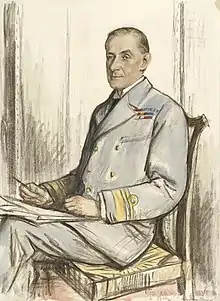William Lowther Grant
Admiral Sir William Lowther Grant KCB (10 November 1864 – 30 January 1929) was a Royal Navy officer who went on to be Commander-in-Chief, North America and West Indies Station.[1]
Sir William Grant | |
|---|---|
 Vice-admiral Sir William Lowther Grant by Francis Dodd | |
| Birth name | William Lowther Grant |
| Born | 10 November 1864[1][2] Southsea, Portsea Island, England |
| Died | 30 January 1929 (aged 64) West Malling, Kent, England |
| Allegiance | |
| Service/ | |
| Years of service | 1877 – 1920 |
| Rank | Admiral |
| Commands held | HMS Cornwallis 6th and 3rd Cruiser Squadrons China Station North America and West Indies Station |
| Battles/wars | Anglo-Egyptian War World War I |
| Awards | Knight Commander of the Order of the Bath |
Naval career
Grant joined the Royal Navy in 1877,[3] and served in the Anglo-Egyptian War in 1882.[3] He was later Commander on board HMS Doris, flagship of the Commander-in-Chief, Cape of Good Hope Station, Admiral Sir Robert Hastings Harris, and was in January 1900 landed in Cape Colony to take part in the Second Boer War.[4] During the next months he commanded a detachment of guns operating in the Orange River Colony, and was specially promoted to captain on 21 October 1900 for services during the war.[5]
Still in South Africa, he was appointed in command of the guardship at Simons Town, the elderly ironclad masted turret ship HMS Monarch on 5 May 1902.[6] After the end of the Second Boer war, he was appointed Naval Advisor to the Inspector-General of Fortifications,[7] and left South Africa on SS Britannic in early October 1902 to take up the position on his return the following month.[8] Appointment as Assistant to the Director of Naval Intelligence followed in 1908, before he became rear admiral providing special service with the Home Fleet in 1910.[3] He served in World War I initially commanding the 6th Cruiser Squadron with cruiser HMS Drake as his flagship.[9] He was made Commander-in-Chief, China Station in 1916 and Commander-in-Chief, North America and West Indies Station in 1918.[3] He retired in 1920.[3]
In retirement he sought to justify Admiral Lord Jellicoe's actions at the Battle of Jutland in the face of German criticism.[10]
Family
In 1892, Grant married Mabel Emily Brodrick, daughter of the Rev. Henry Brodrick and Emily Hester Brodrick.[11]
References
- "Obituary: Admiral Sir Lowther Grant". The Times. The Times Digital Archive. 31 January 1929.
- "Catalogue description: Grant, William Lowther". The National Archives (UK). 15 July 1877. Retrieved 13 May 2019.
- Sir William Lowther Grant Liddell Hart Centre for Military Archives
- "The War - Naval officers at the front". The Times (36053). London. 31 January 1900. p. 10.
- "No. 27244". The London Gazette. 6 November 1900. p. 6779.
- "Naval & Military intelligence". The Times (36761). London. 7 May 1902. p. 10.
- "Naval & Military intelligence". The Times (36887). London. 1 October 1902. p. 9.
- "The Army in South Africa - Troops returning Home". The Times (36899). London. 15 October 1902. p. 8.
- The Dreadnought Project
- Jutland History Evening Post, 1924
- Fox-Davies, Arthur Charles (1895). "Armorial Families". Internet Archive. Edinburgh: T.C. & E.C. Jack, Grang Publishing Works. pp. 132–3. Retrieved 3 November 2017.
External links
- The Dreadnought Project: William Lowther Grant
| Military offices | ||
|---|---|---|
| Preceded by Sir Martyn Jerram |
Commander-in-Chief, China Station 1916–1917 |
Succeeded by Sir Frederick Tudor |
| Preceded by Sir Montague Browning |
Commander-in-Chief, North America and West Indies Station 1918–1919 |
Succeeded by Sir Morgan Singer |